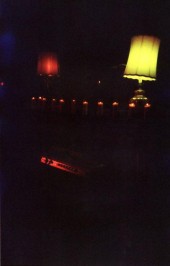how do we "normally" see? mostly we see reflected light. but if we are using a magnifying glass to look at a specimen illuminated from behind, then it is transmission, or absorption, that we are "seeing". so we have the following idea: to see something through a light microscope is to see patches of dark and light corresponding to the proportions of light transmitted or absorbed. we see changes in the amplitude of light rays.
ernest abbe provides the happiest example of a rags to riches story. son of a spinning-mill workman, he yet learned mathematics and was sponsored through the gymnasium. he became a lecturer in mathematics, physics and astronomy. his optical work led him to associate. he was taken on by the small firm of carl zeiss in jena, and when zeiss died he became an owner; he retired to a life of philanthropy. innumerable mathematical and practical innovations by abbe turned carl zeiss into the greatest of optical firms. here i consider only one.
abbe was interested in resolution. magnification is worthless if it "magnifies" two distinct dots into one big blur. one needs to resolve the dots into two distinct images. G. B. airy, the english astronomer royal, had seen the point alread when considering the properties of a telescope needed to distinguish twin stars. it is a matter of diffraction. the most familiar example of diffraction is the fact that shadows of objects with sharp boundaries are fuzzy. this is a consequence of the wave character of light. when light travels between two narrow slits, some of the beam may go straight through, but some of it will bend off at a larger angle: these are first-order, second-order, etc., diffracted rays.
abbe took at his problem how to resolve (i.e., visibly distinguish) parallel lines on a diatom. these lines are very close together and of almost uniform separation and width. he was soon able to take advantage of even more regular artificial diffraction gratings. his analysis is an interesting example of the way in which pure science is applied, for he worked out the theory for the pure case of looking at a diffraction grating, and inferred that this represents the infinite complexity of the physics of seeing a hetereogeneous object with a microscope.
when light hits a diffraction grating most of it is diffracted rather than transmitted. it is emitted from the grating at the angle of first, second, or third order diffractions, where the angles of the diffracted rays are in part a function of the distances between the lines on the grating. abbe realized that in order to see the slits on the grating, one must pick up not only the transmitted light, but also at least the first order diffracted ray. what you see, in fact, is best represented as a fournier synthesis of the transmitted and the diffracted rays. thus according to abbe the image of the object is produced by the interference of the light waves emitted by the principle image, and the secondary images of the light source which are the result of diffraction.
practical applications about. evidently you will pick up more diffracted rays by having a wider apeture for the objective lens, but then you obtain vastly more spherical aberration as well. instead you can change the medium between the specimen and the lens. with something denser than air, as in the oil immersion microscope, you can capture more of the diffracted rays within a given apeture and so increase the resolution of the microscope.
even though the first abbe-zeis microscopes were good, the theory was resisted for a number of years, particularly in england and america, who had enjoyed a century of dominating the market. even by 1910 the very best english microscopes, build on purely empirical experience, although stealing a few ideas from abbe, could resolve as well or better than the zeiss equipment. the expensive craftsmen with trial and error skills were doomed. it was not, however, only commercial or national rivalry which made some people hesitate to believe abbe. in an american textbook of 1916 i find it stated that an alternative (and more "common sense") theory of "ordinary" vision is now once again in the ascendant and will soon scuttle abbe! resistance arose from surprise at what abbe asserted, with the apparent consequence that, as quoatation A has it, "there is and can be no comparison between microscopic and macroscopic vision".
if you hold (as my more modern quotation B still seems to hold), that what we see is essentially a matter of a certain sort of physical processing in the eye, then everything else must be more in the domain of optical illusion or at best of mapping. on that account the systems of leeuwenhoek and of hooke do allow you to see. after abbe even the conventional light microscope is essentially a fourier synthesizer of first or even second order diffractions. hence you must modify your notion of seeing or hold that you never see through a serious microscope.
